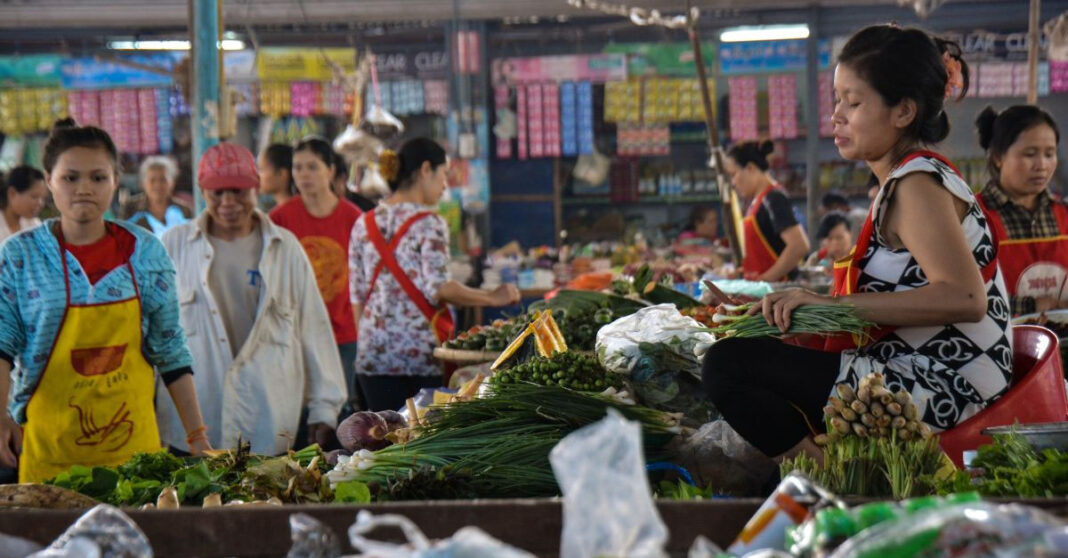Laos is setting an ambitious new course for national growth as the Ministry of Industry and Commerce and the Ministry of Finance have rolled out their five-year development plans for 2026–2030, outlining strategies to accelerate industrialization, strengthen financial stability, and build a self-reliant economy.
At the sixth Party Committee Congress of the Ministry of Industry and Commerce in late October, Deputy Minister Chanthaboun Soukaloun presented the draft Industry and Trade Development Plan, which positions the sector as a central driver of the country’s economic transformation.
The plan sets ambitious targets for the industry and trade sector to contribute at least 36.2 percent to GDP, with projected annual growth rates of 12.65 percent for industry, 14.54 percent for domestic trade, and 10.62 percent for foreign trade.
Over the past five years, the ministry reported steady progress, achieving 180.82 percent of its industrial output target and surpassing foreign trade goals with USD 83.86 billion in total trade value. Building on this momentum, the new plan aims to promote value-added production, develop a competitive energy market, improve trade facilitation, and advance digital and green transformation across industries.
The plan aligns with the government’s broader National Socio-Economic Development Plan (NSEDP), targeting overall GDP growth of 5.5 percent per year.
MSME Challenges Highlight the Need for Reform
During the same congress, Vice President Pany Yathotou called for greater focus on micro, small, and medium enterprises (MSMEs), which employ more than 80 percent of Laos’ workforce but continue to face major barriers to growth.
She warned that without stronger support, Laos risks stifling a sector vital for job creation and economic competitiveness. “MSMEs must be prioritized in national development,” she said, urging simplified procedures, greater transparency, and expanded access to finance.
Access to credit remains the most pressing obstacle. The May 2025 Lao Economic Monitor noted that high government borrowing and a fragile, bank-dominated financial system limit private sector lending. Inflation, currency depreciation, and dollarization have also made loans for small firms riskier and costlier.
Many MSMEs rely on internal funds due to lack of collateral, low financial literacy, and weak business documentation. These issues discourage banks from lending, a concern echoed by Nayoby Bank Deputy Director Bounxord Fongsanith, who said high collateral requirements, often double the loan amount, and poor record-keeping make formal financing “nearly impossible” for small firms.
Administrative hurdles further constrain MSMEs. A World Bank report previously found that complex regulations and inconsistent enforcement keep many businesses informal, limiting their potential contribution to economic growth.
Without urgent reform, experts warn, Laos’s most important job creators will continue to struggle, a challenge the Ministry of Industry and Commerce’s new five-year plan aims to address through financing reforms and business environment improvements.
Finance Ministry Strengthens Fiscal Management and Reform
Meanwhile, at the fourth Party Committee Congress of the Ministry of Finance, Santip Phomvihane, a member of the Party Central Committee, was elected Secretary of the Ministry’s Party Committee for the fourth term.
The congress, attended by Prime Minister Sonexay Siphandone and senior Party officials, reviewed the achievements of the previous five-year plan and approved the new financial sector development plan to 2030.
The finance sector’s new plan emphasizes fiscal discipline, improved revenue management, and enhanced coordination with other ministries to ensure that financial policies effectively support national development priorities.
Delegates also reaffirmed the ministry’s commitment to comprehensive reform in line with the Party’s principles and the government’s modernization agenda.
Both ministries’ new strategies aim to build a self-sustaining economy driven by industry, trade, and sustainable financial governance.
Central Bank Targets Stability and Modernization
The Bank of Laos (BOL) also unveiled its own five-year plan for 2026–2030 during its fifth Party Congress held on 26 October in Vientiane.
According to Governor Bounkham Vorachit, Secretary of the Party Committee, the plan prioritizes financial stability, stronger oversight, and innovation in digital banking to enhance inclusion and efficiency. It also builds on past efforts to modernize the financial sector and improve transparency.
Amid these reforms, the central bank is accelerating its digital modernization and regional integration agenda. Cross-border QR payment systems with Thailand, Cambodia, Vietnam, South Korea, and China now enable seamless cashless transactions for tourists and businesses, supporting both financial transparency and the country’s digital economy goals
Recent challenges in the banking sector have also highlighted the urgency of these reforms.
In 2024, the Bank of Laos reported 21 corruption cases, including incidents within BOL and several state-owned banks, resulting in losses of nearly LAK 1.6 billion (approximately USD 74,000), of which only LAK 137 million (about USD 6,300) has been recovered.
A total of 167 individuals faced disciplinary action, while investigations continue at major financial institutions. These issues, the bank noted, highlight the need for stronger accountability and tighter oversight mechanisms to protect public trust and ensure financial integrity.



